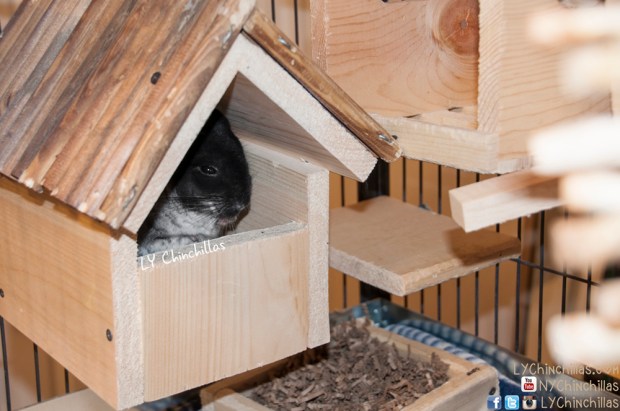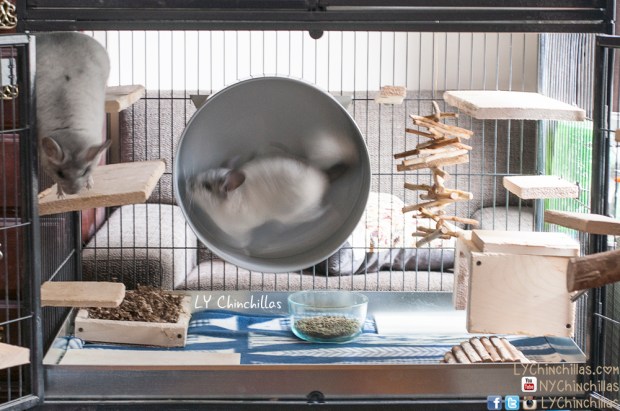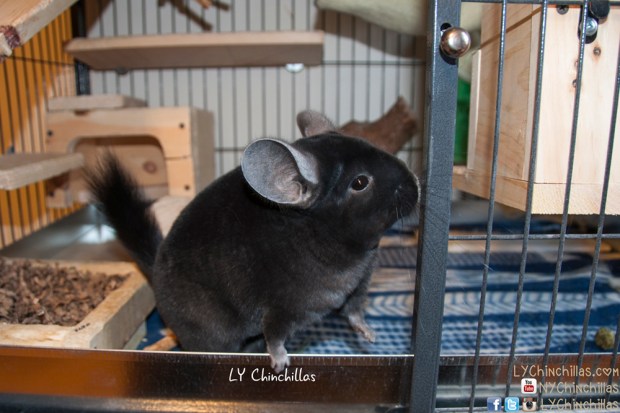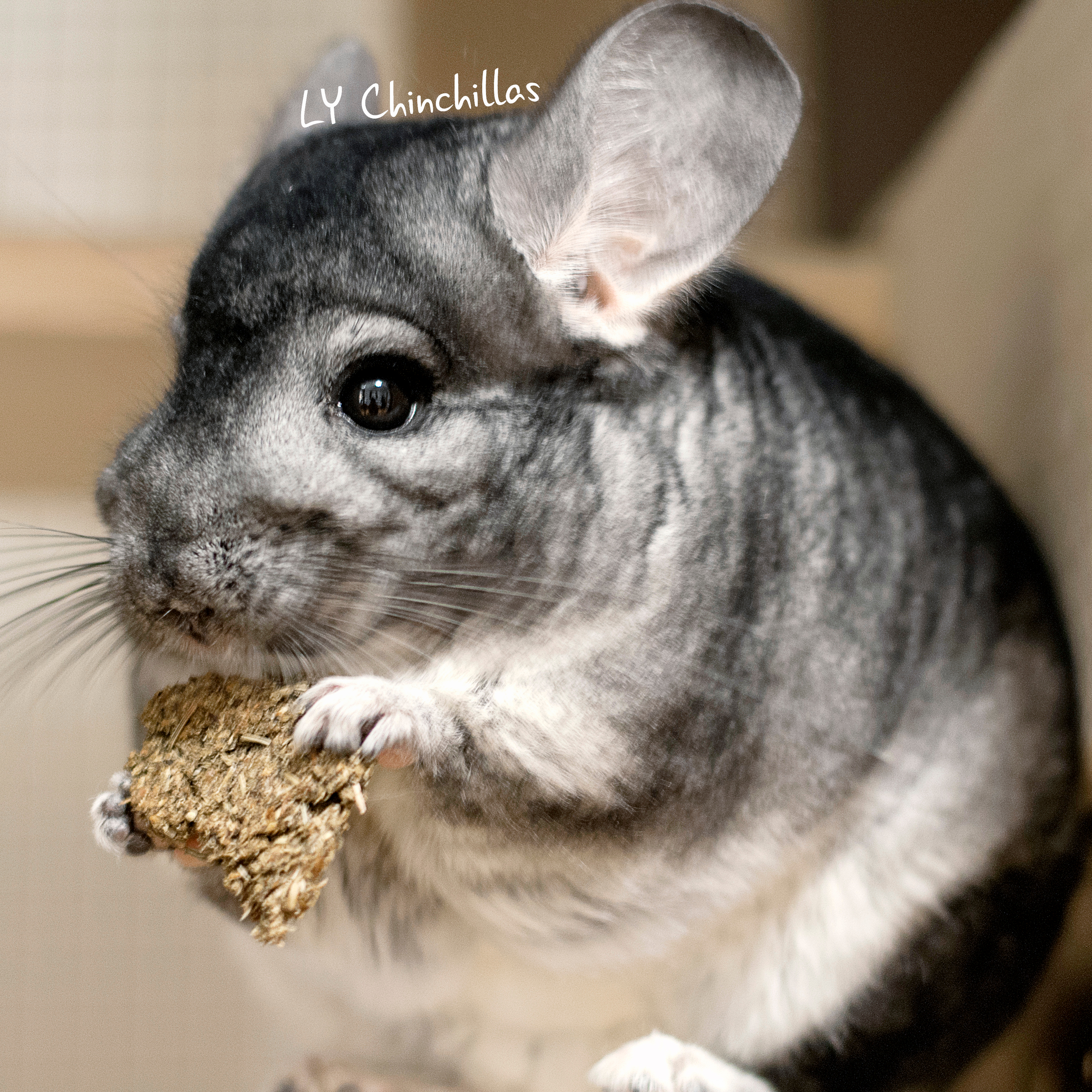Have you ever wondered how best to handle your chin? Well, wonder no more! Here’s a quick video to help guide you on your start to safely holding, transporting, and handling your chinchilla.


Have you ever wondered how best to handle your chin? Well, wonder no more! Here’s a quick video to help guide you on your start to safely holding, transporting, and handling your chinchilla.

In tandem with recent posts about Ferret Nation Cages and How To: Build a Custom Chinchilla Cage, this post is all about cage details – all the necessary components that help make your chin’s cage feel like a meaningful, functioning home! Although there are online vendors for listed accessories, all items that are realistically able to be made at home have been described in a DIY manner.

Platforms & Ledges: I suggest keeping platforms 4-5″ wide, installed under 6” apart height-wise for safety. Any higher, and a fall could potentially hurt your chin. And don’t forget ledges – fun shapes for corners, sides, and all around. Sizes can vary, from 3″ upward. The hardware part is simple: screws, washers, and a drill will keep your items snug and secure.

Hay Feeders: Hay is an integral part of any healthy chinchilla diet, and it gets everywhere! Our cages have DIY hay feeders, complete with a standing perch for easy eating. Connected with two sturdy hooks, these feeders are a chin favorite, adhere to horizontal bars with ease, and keep the mess minimal!
Food Bowls: We recently switched from bottom-heavy bowls to stainless steel bowls that adhere directly to cage bars. It’s been a wonderful transition, as the stainless steel bowls are sleek, safe, attractive – and most of all, easy to use.

Litter Boxes: Read this post all about DIY litter boxes and litter training! Litter boxes can be a tidy addition to your chin’s cage, encouraging your pets to maintain their space and keep clean. Of course, not all chinchillas can be litter trained, but it never hurts to try.

Huts & Houses: The fluffs love hiding houses, tight corners, and crunching down on the very infrastructure they inhabit. The best way to inhibit this type of behavior is by encouraging it in a safe, healthy manner! Our hideaways are made from kiln-dried pine and offer privacy-seeking chins a lovely respite from the craziness of their peaceful environments (because we all know being a well-cared-for chinchilla is exhausting). 😛

Stone Cooling Tiles: Our chins prefer marble or granite cooling tiles; they are a great accessory for the active buggers who dart all over their cages, working up some heat! The tiles offer temporary relief for warm tummies, but only act effectively if hand-in-hand with low temperatures or air-conditioning.

Hanging Toys: Hanging toys are quite simple to make, and shockingly fun to watch as your chins swing them from side to side in impatient demolition attempts. Some drilled apple sticks, chunks of kiln-dried pine, and pumice stones make for a really great time – especially for the attention deficit types!

Hammocks and Tubes: While not every chin enjoys hammocks, a lucky few really do love lounging in comfy floating fleece blankets. There’s nothing like a softly swinging sleepy chinchilla to bring a smile to your face! Tubes are also great accessories, offering a round retreat for your fluffballs. I use galvanized steel ducts, which have rounded steel that can be used safely without fleece coverings. Other tube options include PVC or cardboard tubes with snug fleece covers to prevent harmful ingestion.

Cuddle Buddies: Fleece teddies can be perfect for solo chinchillas! As long as the cuddle buddy has fine stitching and good construction, your chin will be snuggling up next to their new friend (or tossing it around) in no time.
Water Bottle: Water bottles are the bane of my existence. As I’m living in the city, I do not have an adequate setup for a water pump system. So, I run through glass water bottles every few months. I always have two water bottles in each cage, a 32 oz. and an additional 16 oz., just in case. Currently, I use Kaytee, Living World, and Lixit (although I’ve tried more than a handful of brands), and simply cross my fingers. I have never understood why water bottles do not have any type of manufacturer’s warranty, as they are often faulty and fail to stand the test of time.

Running Wheel: Although chinchillas do not require a wheel, it is nice to have one for exercise purposes. My chins have a running wheel in a separate playtime cage, which is an excellent way to encourage a weekly allotment of exercise while teaching them to manage their stress when being introduced to different environments.

Fleece: The safest fabric for chins, fleece is a good way to cover up harmful plastics in your cage or line the bottom of your cage with a pretty pattern. While fleece is not necessarily easier to clean than bedding, it does help make your chin’s home more personal. If your chin is litter trained, I suggest washing fleece every 2 weeks with a hot water and lemon juice/vinegar mixture. If your chin is not litter trained, fleece should be washed weekly to prevent urine buildup. It’s important to note that while most chins do not eat fleece, some will try! If that’s the case, then fabric should be removed immediately to prevent consumption.

Custom Steel Pans: Galvanized or stainless steel pans for your chin’s cage are an awesome investment – they are easy to manage and long lasting with proper care. Swapping out plastics for steel is a simple way to prevent harmful ingestion, blockage, or impaction that can come with gnawing malleable plastics.

As always, try to incorporate safe woods into your chin’s environment, and understand the importance of choosing wood over plastic. Be sure to always have an air-conditioning unit (or two!) during warm months, keep a regular dusting routine, and monitor your chin’s weight for changes in consumption in order to catch early warning signs of illness. 🙂


LY Chinchillas Treat Donation
Donate healthy, delicious treats to LY Chinchillas to help keep our content going!
$5.00
After spending a decent amount of time on social media posting about my fur-babies and receiving feedback, I’ve come to realize that there are quite a few people out there with very basic questions about chinchillas. It seems I’ve skipped right over that in my blog and discussed more complex issues! In an effort to condense all beginner Q&A in one area, I’ve decided to do a very simple blog post with a lot of information this week: Chinchilla Basics 101.

What is a chinchilla? A chinchilla is super soft crepuscular rodent, native to South America’s Andes. Simply because these animals have a rodentia classification, they are no ordinary rodent: they are extremely clean, beautiful animals with a great depth of emotive and intellectual capability. Their name means “little Chincha,” named after the indigenous Chincha people of the Andes. Crepuscular means that chinchillas are most active at dawn and dusk. It is a common misconception that chins are nocturnal, as they are not. In the wild, they’ve been known to live at high altitudes in herds of up to over 100 chinchillas, but as a pet, can be very picky about which chinchilla(s) he or she wants to live with. Chinchillas have poor eyesight but a strong sense of smell, hearing, and through their whiskers, touch. Through their whiskers, they can sense pressure changes and vibrations. They also have excellent memories and are incredibly fast, agile, and can be very high jumpers. Chinchillas are very intelligent and have specific personalities and preferences, which means it can take quite a while to bond and get to truly know your chinchilla. How long can a chinchilla live? Chinchillas can live upwards of 20 years with strong genetics and a healthy diet, although the average is 12-15 years. Chins are no short-term commitment, meaning that a lot of consideration must be made prior to buying your first chinchilla. Your heart may start in the right place, but due to your wallet, growing family, or lost interest, you may put a sweet chinchilla out of a good home, causing this intelligent and emotional animal to become neglected and end up in the hands of someone who doesn’t care to research a chinchilla’s needs as well as another first-time owner. In such a case, you are encouraged to reach out to a chinchilla rescue and research the best options for your pet.

Are chinchillas considered exotic pets? Chinchillas are critically endangered animals, having been hunted to near-extinction for the profit-hungry fur industry – 90% killed off in the wild in the span of a mere 15 years. They are indeed exotic (although not in terms of import/export in the United States) – there has yet to be extensive scientific research on their species, in terms of intellectual, emotional, or physical capabilities, outside of some agricultural uses. Most of what chinchilla owners know beyond the very basics is based largely on first-hand experience, opinion, or what we have gathered about chinchillas prior to hunting them out of the wild. Since chins have been domesticated, bred in captivity, and raised as pets, chinchilla breeding has become an art of sorts – with very beautiful colors (i.e. Blue Diamond) and variations (i.e. Royal Persian Angora and Locken), in extremely exclusive markets (i.e. select markets have refused to sell to others, keeping the costs of certain variations of chinchillas in the high thousands). Aside from color mutations and breeding variations, chinchillas are all-around very special animals, with special needs. A few of these needs are:

Are chinchillas easy to care for? No. Do not be fooled by pet stores or oblivious owners. If you are a caring owner, chinchillas are not easy pets. Be prepared to spend at least an hour a day with these guys, especially if you want to bond with them. My family has often told me my energy and time dedicated to my 5 chinchillas is very similar to owning a mid-sized dog (albeit a dog that can live up to 20 years), and I wouldn’t disagree. It requires just as much time, money, energy, and emotion to adequately provide what I consider to be a happy life for these guys. Does it get easier? Yes. With time, routine, and a little bit of help from your loved ones, caring for your chinchillas is like riding a bike – still takes energy, but you get stronger with experience.

Why do chinchillas need dust baths? Because chinchillas have around 60 hairs per follicle, their fur is the densest in the world. Their fur is so dense that they cannot contract fleas, nor bathe in water to clean themselves. Their fur is not be able to dry naturally and could create deadly fungus or other skin conditions if not treated immediately (AKA carefully blow-dried on the coolest setting). In the wild, chins bathe in volcanic ash to ensure the richness and cleanliness of their dense coats, which helps to remove moisture and oil. In captivity, chins bathe in a very similar dust (created from ultra-fine aluminum silicate powder), often branded as Californian blue cloud dust. If your chinchilla has dry skin problems (this can occur in dryer times of the year), dust 2-3 times per week. If your chinchillas have no skin issues and love to dust, daily dusting is totally fine!
What items do I need/should I buy for my first chinchilla?
Start there, and learn as you go! Sure, as time goes on you’ll probably look into a wheel, hammock, cuddle buddy, and other fun accoutrements for your pet. But basics are basics, and that’s what this post is all about. I hope you find this helpful, and feel free to share with your friends and acquaintances – you know, the ones who ask, “What’s a chinchilla?” 🙂


LY Chinchillas Treat Donation
Donate healthy, delicious treats to LY Chinchillas to help keep our content going!
$5.00
Hi everyone, happy first Wednesday of 2015! For this week’s post, I’ll be listing off woods and chews that can safely be used for wearing down your chinchilla’s constantly growing teeth and help combat boredom. I have collected a cross-referenced list of chinchilla-safe woods, with the help of a few chinchilla friends, studious family members, breeders, and my personal knowledge accumulated over the years.

All chinchilla woods and chews should be organic, pesticide-free, and untreated. This is not a fully comprehensive list, however woods not found on this list should be carefully researched prior to consumption. All woods should be thoroughly cleaned, boiled, and baked prior to gifting to your chinchilla (obviously with the exception of already prepared or kiln-dried woods). I have used bold print for the more commonly sold and distributed ready-to-chew woods, which should be easier to find and purchase for immediate pet consumption in the United States.



The following items are not woods, but chew alternatives. These elements can be used for toy-making. Again, all of these items should be organic, pesticide-free, and untreated.

While there could be many more leaves, herbs, and flora to add to this list, I’ll save the rest for a “Safe Herbs” post later this month!
In the meantime, don’t forget to follow the blog for our Weekly Wednesday blog posts, and catch up with us on social media: Facebook, Instagram, Twitter, Vine, and YouTube! We hope you have a great week and stay warm! 🙂

LY Chinchillas Treat Donation
Donate healthy, delicious treats to LY Chinchillas to help keep our content going!
$5.00